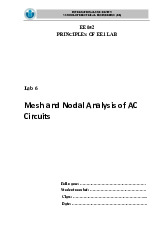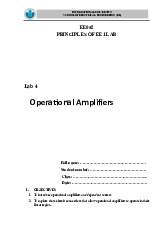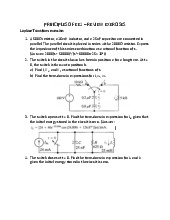





Preview text:
International University
School of Electrical Engineering
PRINCIPLES OF EE1 LABORATORY EE052IU
[Introduction To Electric Circuit]
International University 1 [Course number] School of EE
GRADING GUIDELINE FOR LAB REPORT Number Content Score Comment 1 Format (max 9%) - Font type Yes No - Font size Yes No - Lab title Yes No - Page number Yes No - Table of contents Yes No - Header/Footer Yes No
- List of figures (if exists) Yes No
- List of tables (if exists) Yes No - Lab report structure Yes No 2
English Grammar and Spelling (max 6%) - Grammar Yes No - Spelling Yes No 3
Data and Result Analysis (max 85%) Total Score Signature: Date:
International University 2 [Course number] School of EE Table of Contents
List of Figures .................................................................................................................................. 3
List of Tables ................................................................................................................................... 3
Nomenclature ................................................................................................................................... 3
Theoretical Background .................................................................................................................. 3
Experimental Procedure .................................................................................................................. 4
Experimental Results ....................................................................................................................... 6
Discussion of Results ................................................................................................................... 7 List of Figures
Figure 1 –………………………….……...…………………………………………………… 4
Figure 2 – …………………………………………………………………..……………...….. 4
Figure 3 – ……………………………………………………………………………………... 5 List of Tables
Table 1 – ……………………………………..……………………........................................... 6
Table 2 – ……………………………………..……………………........................................... 6
Table 3 – ……………………………………..……………………........................................... 6 Nomenclature VDD = DC Voltage Source Vdd = AC Volatge Source Iref = Reference Current Etc. Theoretical Background
In this section, describe the different circuit designs, show mathematical equations, and simulated
output. When inserting an equation, use the Equation Editor, e.g.: R2
International University 3 [Course number] School of EE [1+ ] R1 Vos = Vo/
You should also include schematics, and discuss expected results. Experimental Procedure
1. Measure Voltage Differences
Build the simple circuit shown, Vi = 5(V) (DC voltage), then measure the amplitude of the signals
at A and B with respect to ground. Figure 1 2. Voltage Divider
Display the signal generator output, note its amplitude, then connect the1k potentiometer as shown.
Connect the B probe to the sliding output of the potentiometer. Figure 2
3. Investigate a Current Divider
Build the current divider shown below, using RAC = 2k, 10k, 15k respectively.
International University 4 [Course number] School of EE Figure 3
International University 5 [Course number] School of EE Experimental Results
1. Measure Voltage Differences Here is the result for circuit. Calculation Meansure Error VAB 0.45V 0.4565V 1.4V VBC 4.55V 4.525V 0.5V VCD 0 0.398V 0 VAD 5V 4.982V -0.36V VCB -4.55V -4.522V -0.61 Table 1 2. Voltage Divider
Here is the result for circuit. Calculation Meansure Error VAB 1.7836V 1.7789V -0.2635V VBC 3.2164V 3.2671V 1.5763V I1 1.78×10-3 1.79×10-3 0.56A I2 3.21×10-4 3.27×10-4 1.8692A I3 1.46×10-3 1.49×10-3 2.05A Table 2
3. Investigate a Current Divider Here is the result for circuit. RAC 2000Ω 10000Ω 15000Ω VAC 4.528V 2.5519V 1.335V VAB 0.4499V 2.4281V 3.6469V Table 3 Discussion of Results
In the lession, we learned about how to use breadboard and the way to read resistor color codes
and capacitor code. The exercises show us the difference between calculations and reality when
measuring electrical circuits. This is the foundation to know more about the principles of EE.
International University 6 [Course number] School of EE




